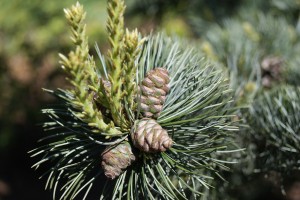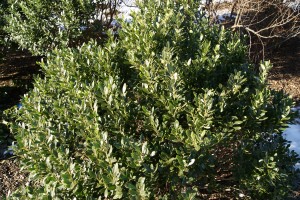What’s in Bloom: Winter Interest
I wish I had been in town for the first snow of the season. How exciting to grab the camera, early, and take pictures of ice and snow covered branches, leaves and stems. While I wait patiently for another gentle snow (with perfect timing for a good commute and no severe damage) I am walking the Greenway parks on the lookout for interesting winter sights.
This is a good time to appreciate the structure in your garden. Notice the conifers and the broadleaf evergreens throughout your garden and our parks. Do they add round, mounded shapes to contours of the beds? Are they fastigate and upright, or peaked liked pyramids? Two of the Greenway’s workhorse evergreens fall into this broadleaf category, Ilex glabra, commonly known as Inkberry, and Ilex x meserveae, or Blue Holly. Broadleaf because their leaves are bigger than the needles and scale-like leaves on conifers, not because they are always wide and broad like a rhododendron leaf.
The “Blue Hollies” are hybrids between the rock-hardy Prostrate Holly (I. rugosa) and the more decorative English Holly (I. aquifolium). They have a shiny, glossy dark green and leathery leaf with spines along the edges, often set off by red or purple stems. These slightly pyramidal shrubs, maturing between 10 and 15 feet, can be quite a presence in an open space. They provide year round screening, and are a wonderful dark backdrop to summer blooms. The female plants, Ilex x meserveae ‘Blue Girl’ and ‘Blue Princess’ have bright red fruit that stay on through most of the winter or until it mellows and the birds discover it. The male plants bloom all summer, though the flowers are relatively inconspicuous.
Our native Inkberry is one of my favorites. Not as stiff, and certainly more user friendly than the spiny Blue Hollies, Ilex glabra is best planted in small groups or sweeps. It grows into a nice, rounded silhouette on a slope and more than holds its own in a border or hedge. While it has plain black berries and are not as showy as the red ones of Blue Hollies or the native Winterberry (yet another ilex, Ilex verticillata), these also add interest throughout the season. While you will find Inkberry most readily in our Fort Point Channel Parks, it is an eastern US native, easily at home in seashore environments and native plant designs.


